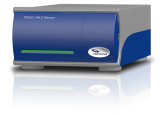The Postnova PN3621 MALS detector system offers full 21 angles and has the broadest angular range of any commercial light scattering instrument available today for high molar mass polymers and large particles.
Maximum Angle Number
The Postnova PN3621 MALS detector system offers full 21 angles and has the broadest angular range of any commercial light scattering instrument available today. The benifit is the highest quality data fit for high molar mass polymers and large particles.
Unique Low Angle Range
The number of low angles between 0° and 35° (7°, 12°, 20° and 28°) are the most important for precise molar mass and particles size determination calculation. In Static Light Scattering this offers new and outstanding options especially for larger and more complex samples, such as branched polymers, high molar mass macromolecules, large protein aggregates and nanoparticles.
Clean Vertical Flow Cell
The gentle way of treating the samples the Clean Vertical Flow Cell in comparison to highly turbulent light scattering cells is to avoid:
- any alteration
- potential shear forces
- chain degradation
- conformational changes
- deterioration of complete loss of bioactivity
this is important for larger sample species, such as protein aggregates, high molar mass macromolecules and particles.
Our Clean Vertical Flow Cell has a edge free design without dead volumes to avoid negative site effects such as Aggregation, adsorption or sedimentation phenomena.
The sample can pass through easily without any obstacles in its way.
Advanced Electro Optics and small footprint
The PN3621 MALS employs:
- latest opto-electronic designs
- digital signal processing for each of the 21 angles
- electronics based on a true 24 bit resolution AD system
- broad dynamic signal range.
For maximum flexibility it is possible to read-in up to 3 external analogue signals.
The PN3621 has the smallest footprint available in the market, saving rare lab space and allowing a flexible use at different locations and also seamlessly fi ts into the line of other Postnova products, such as the PN3150 Refractive Index detector.
Broadest Application Range
Because of its unique design and advanced performance features, the instrument is ideally suited for the most challenging applications from various areas in science and technology:
Biotechnology: Alginates, Carrageenans, Hyaluronic Acids, Cell Organells, Exosomes
Biopharmaceutical: Peptide, Protein, Antibody, Virus Aggregates and Conjugates
Food and Agro Science: Starches, Pectins, Polysaccharides, Proteins, Casein Micells
Polymer Science: Rubbers, Latex Dispersions, Polyolefi ns, Polyelectrolytes
Environmental Research: Humic-Fulvic Colloids, Iron Oxides, Clays, Silica Particles
Nanotechnology: TiO2, CNT, C60, Latex, ZnO Nanoparticles and Silica Nanoparticles


